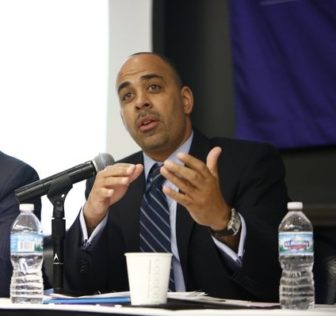 As America grapples with its overreliance on incarceration and advocates call for the end of mass incarceration, we must also focus on reducing all criminal justice involvement, including probation. By far the largest segment of the criminal justice system in America is probation. There are more than seven million people in the country under the control of the criminal justice system. More than half, just under four million, are not in prison but under the supervision of probation.
As America grapples with its overreliance on incarceration and advocates call for the end of mass incarceration, we must also focus on reducing all criminal justice involvement, including probation. By far the largest segment of the criminal justice system in America is probation. There are more than seven million people in the country under the control of the criminal justice system. More than half, just under four million, are not in prison but under the supervision of probation.
Although probation is technically an alternative to incarceration, most people on probation have spent time in custody prior to being released onto probation supervision and many more end up incarcerated for technical violations of probation. And the growth of probation has even outpaced the enormous increase in the prison population.
In 1980, just over 800,000 people were on probation — today there are 4 million. There are nearly twice as many people on probation in the United States than incarcerated. And while we spend $80 billion per year to lock people up, we spend more than $300 billion to operate the entire criminal justice system.
For youth, numerous studies have revealed that system involvement in and of itself is harmful and leads to worse outcomes. A large study conducted by Anna Aizer and Joseph J. Doyle in 2013 concluded that youth involvement in the juvenile justice system resulted in “large decreases in the likelihood of high school completion and large increases in the likelihood of adult incarceration.”
National Public Radio produced a detailed report on how “Probation Can Be More Challenging than Detention.”
A few jurisdictions have significantly reduced probation rolls, which has actually resulted in decreases in crime and saved resources. Los Angeles County Probation went from a high of approximately 23,000 youth on probation to 8,000 today. New York City reduced the number of people on probation from 68,000 in 1996 to 21,379 in 2014, according to the New York State Division of Criminal Justice Services.
Even with recent reforms, far too often probation remains a game of “trail ’em, nail ’em, jail ’em.” Frivolous violations often result in unnecessary detention. And young people can be kept on probation for many years. In many jurisdictions, a young person can be placed on probation for something as minor as petty theft at age 13 and serve five years on probation, going in and out of detention for technical violations of onerous probation conditions.
The golden rule for juvenile justice is that less is better. Limited, focused services on youth assessed as high risk with a positive youth development approach is the best use of probation resources.
For more information about COMMUNITY-BASED ALTERNATIVES, go to JJIE Resource Hub | COMMUNITY-BASED ALTERNATIVES
Here are a number of measures local probation departments can implement to responsibly reduce their over-reliance on correctional supervision:
- Do not actively engage or supervise any youth assessed as low risk: Youth assessed as low risk are especially harmed by system involvement. Studies have found that doing nothing with a low-risk youth may actually result in better outcomes on average than including youth in the juvenile justice system.
- Reduce the length of time youth spend on probation to no more than 12 months: Placing youth on probation for long periods is ineffective, inefficient and detrimental. And keeping youth on probation for long periods contributes to higher caseloads, which tax probation officers and can distract them from giving appropriate attention to higher-risk youth.
- Do not send any youth to correctional facilities or out-of-home placement unless they are assessed as high risk, and do not keep most youth in placements longer than six months: Jurisdictions should only use out-of-home placement if a youth has been assessed as high risk and is in need of treatment services that only a residential setting can provide. Most so-called “placements” are private, large congregate care facilities.
- Implement a policy or response grid that provides graduated sanctions and rewards for youth on probation that reduces the filing of violations.
- Only detain youth brought to juvenile detention centers who score high on the risk assessment instrument.
- Develop and offer a robust array of detention alternative programs: The probation department and the courts should have an ample, effective continuum of alternatives available so that detention is only used as a last resort.
These responsible, common-sense measures can effectively reduce youth probation populations. Implementing these reforms would result in more efficient probation operations and better outcomes for youth.
David Muhammad is the executive director of the National Institute for Criminal Justice Reform. He is the former chief probation officer of Alameda County in California and the former deputy commission of probation in New York City.